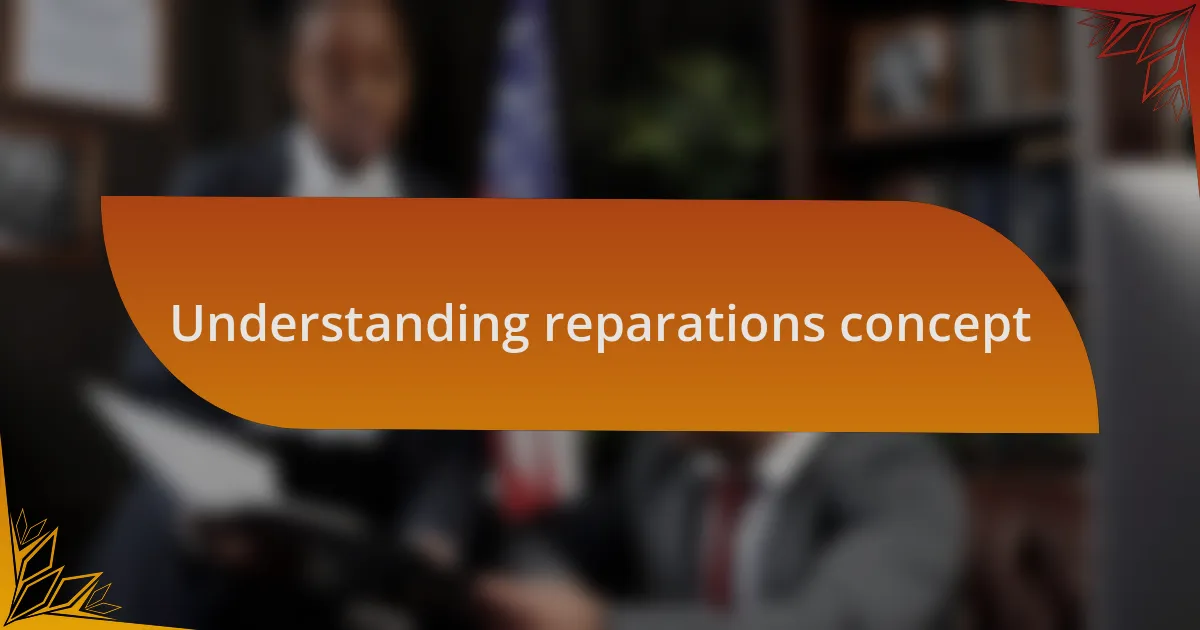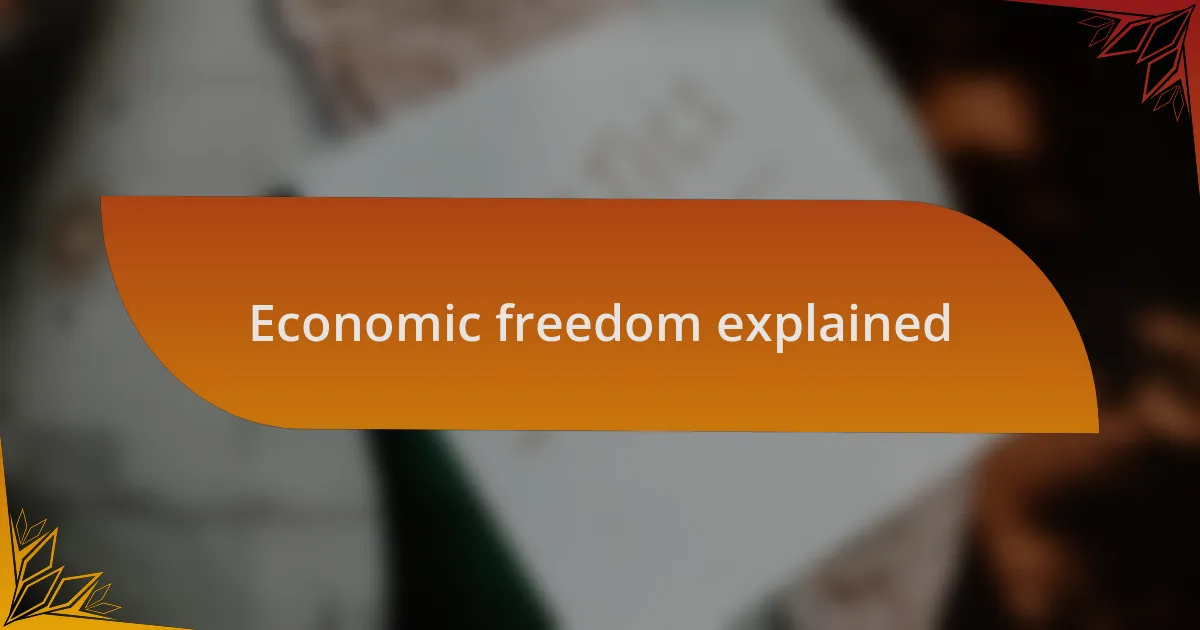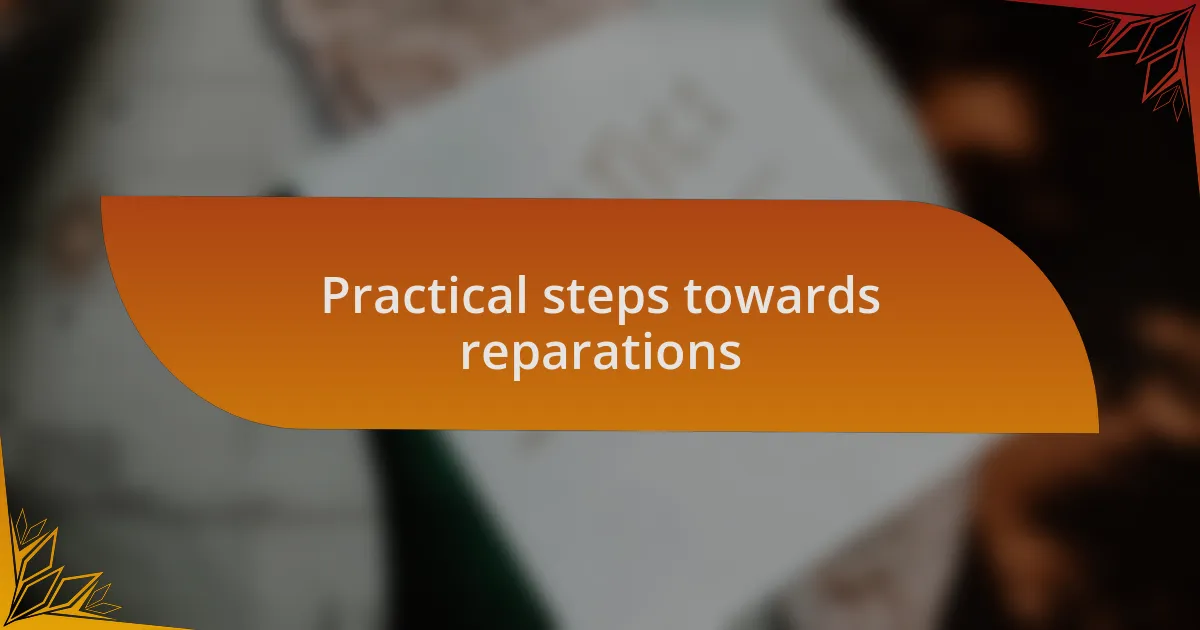Key takeaways:
- Reparations involve acknowledging past injustices and require both financial compensation and systemic reforms for long-term economic freedom.
- Historical examples, such as post-Civil War promises and Germany’s reparations to Holocaust survivors, illustrate the complexities and varying commitments to reparative justice.
- Economic freedom is critical for individuals to control their resources and achieve success, and reparations can offer the necessary support for marginalized communities to flourish.
- Practical steps toward reparations include involving affected communities in planning, creating dedicated funds for education and entrepreneurship, and advocating for policy changes to ensure equitable resource access.

Understanding reparations concept
Reparations, at its core, is about acknowledging past injustices and providing compensation to those affected. When I reflect on this, I can’t help but think about the history of marginalized communities and the economic disparities that persist today. How can society truly move forward if it doesn’t address the wrongs of the past?
In my own experience, understanding the reparations concept requires recognizing the weight of historical trauma. I once spoke to a friend whose family faced discrimination for generations; the emotional scars still linger for them, impacting their economic stability. This conversation made me realize that reparations aren’t just financial—they’re an important step toward healing and restoring dignity.
What often strikes me is the complexity of implementing reparations. It isn’t merely about financial payment; there’s a need for systemic reforms that ensure long-term economic freedom. As I ponder on this, I ask myself: can we genuinely create a just society without confronting these deep-rooted issues? The answer, I believe, lies in acknowledging the past while actively working towards a more equitable future.

The history of reparations
The history of reparations is marked by various significant moments throughout the years. For instance, the aftermath of the American Civil War saw the introduction of “Forty Acres and a Mule,” a promise to provide land and resources to formerly enslaved individuals. Unfortunately, this promise was largely unfulfilled, emphasizing the deep-rooted challenge in realizing reparative justice.
Looking into global instances, post-World War II, Germany provided reparations to Holocaust survivors, acknowledging the immense suffering caused by the regime. Reflecting on this, I wonder: could similar approaches effectively address the injustices faced by Black communities in America? The contrast in how societies have responded to historical wrongs raises critical questions about commitment to fairness.
In more recent times, discussions around reparations have gained momentum, particularly in the United States. Activists have advocated for comprehensive plans, highlighting the economic disparities perpetuated by systemic racism. I often think about how these efforts represent not just a financial transaction but a meaningful attempt to rectify historical wrongs. Isn’t it time we seriously considered the possibility of reparations as a pathway to economic freedom and equity?

Economic freedom explained
Economic freedom is the fundamental right of individuals to control their own economic resources without excessive interference from the government or other institutions. It encompasses access to opportunities for entrepreneurship, investment, and the ability to make choices that affect one’s financial well-being. When people are economically free, they have the ability to improve their lives, invest in their skills, and contribute positively to their communities.
From my experience, economic freedom doesn’t just open doors; it can change lives. I recall speaking with a business owner who, after decades of systemic barriers, finally found the opportunity to launch her own small enterprise. Her narrative illustrates how economic freedom allows individuals to chase their passions and inspire others, turning aspirations into reality. Isn’t it fascinating how one opportunity can spark tremendous change?
The interplay between economic freedom and reparations is particularly intriguing. Often, I ponder whether reparations could pave the way for true economic autonomy for marginalized communities. If we offer resources and support, can we not build a framework where individuals can flourish independently? I believe the answer lies in understanding that economic freedom isn’t just about money; it’s about empowering people with the tools they need to succeed.

Personal reflections on reparations
Personal reflections on reparations
When I think about reparations, I can’t help but reflect on the stories of my friends and family who have faced economic injustices. There was a close friend of mine whose grandparents were denied land ownership because of their race; the impact of that decision rippled through generations. How different might their lives have been if that opportunity had been available to them? Moments like these highlight the urgent need for reparations, not just as financial compensation but as a form of recognition and restoration.
In another instance, I remember working with a young activist passionate about racial equity. She described her struggles in accessing educational resources compared to her peers from different backgrounds. Listening to her, I felt a deep sense of frustration and determination—reparations could address these disparities, help level the playing field, and break the cycle of poverty. Shouldn’t everyone have an equal shot at success?
Ultimately, I see reparations as a bridge to a more equitable society. It’s about acknowledging past wounds and fostering hope for a future where everyone has the chance to thrive. I often wonder, can reparations truly inspire a cultural shift towards understanding and acceptance? I believe they can—by addressing long-standing disparities, we encourage a collective healing that benefits all of society.

Practical steps towards reparations
To move towards reparations, it’s crucial to develop a comprehensive framework that identifies affected communities and their unique needs. I remember attending a community meeting where local leaders discussed the importance of involving those directly impacted in the planning process. It struck me how essential it is for decision-makers to listen and understand these perspectives for any reparative measures to be truly effective.
Another practical step could involve creating dedicated funds for education and entrepreneurship in underserved communities. I once sat down with a group of young entrepreneurs, each with dreams bright enough to spark change but limited by financial barriers. Providing grants or low-interest loans can empower individuals, fostering economic independence and opportunity. Isn’t investing in people one of the best ways to ensure long-term societal improvement?
Furthermore, policy changes that promote equitable access to resources are vital. I recall a conversation with a local nonprofit worker who shared how zoning laws often disadvantage minority communities. Advocacy for systemic changes, such as revising these laws, can pave the way for more equitable distribution of resources. By addressing these foundational issues, aren’t we taking a significant step toward reparative justice?